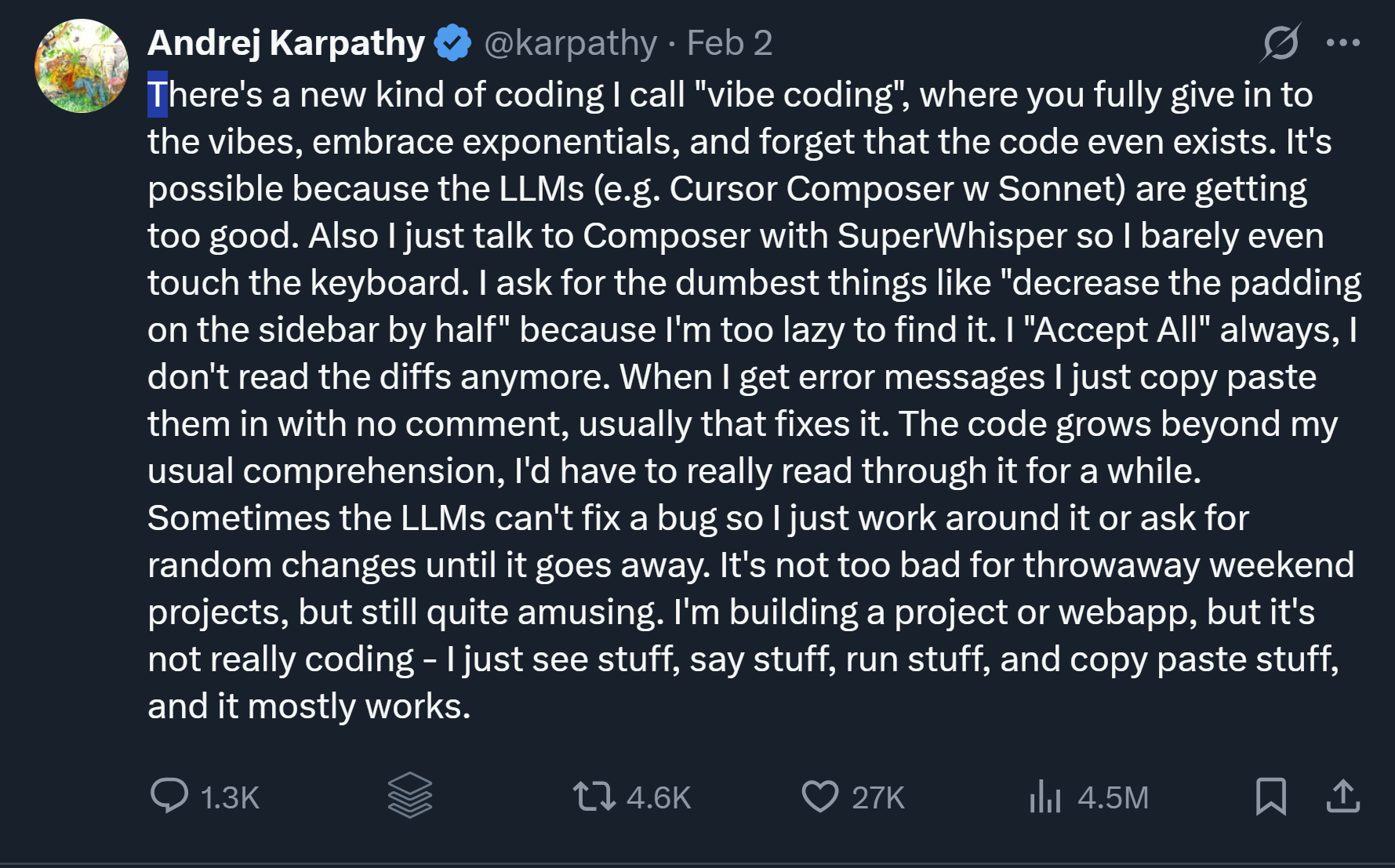Large language models are changing how people write software. However, not all AI-assisted coding works the same way. Vibe coding offers a looser, more conversational approach—less about writing every line yourself, more about shaping what the AI gives you until it feels right. It’s a different kind of programming.
 Vibe coding is a new way of thinking about software development in the age of large language models (LLMs). Popularized by Andrej Karpathy in early 2025, the term captures a shift in the programmer’s role—from writing code line by line, to expressing intentions in natural language and collaborating with AI systems to bring those intentions to life. It’s a style of programming where you describe what you want, feel out whether the AI’s response is in the right direction, and keep iterating until the vibe is right.
Vibe coding is a new way of thinking about software development in the age of large language models (LLMs). Popularized by Andrej Karpathy in early 2025, the term captures a shift in the programmer’s role—from writing code line by line, to expressing intentions in natural language and collaborating with AI systems to bring those intentions to life. It’s a style of programming where you describe what you want, feel out whether the AI’s response is in the right direction, and keep iterating until the vibe is right.
In traditional programming, developers write code by hand, translating ideas into precise syntax and logic. Vibe coding, by contrast, begins with a prompt—”Build me a simple calendar app,” or “Write a script that renames all files in a folder based on date.” The AI generates a draft of the code, and the human developer becomes a curator, guide, and editor. They review the output, tweak it, add constraints, and test until the result feels aligned with their goals.
This mode of working brings a different rhythm to coding. It’s less about syntax and more about steering—less about rote knowledge and more about judgment, intuition, and iteration. The developer still needs technical skill, especially to validate and refine the code, but the focus shifts to high-level design, debugging, testing, and knowing how to ask the right questions. Vibe coding makes programming more conversational, and potentially more accessible.
That accessibility is part of the excitement. Vibe coding opens up software creation to a broader group of people—those who understand what they want but haven’t traditionally been able to build it themselves. Writers, designers, educators, and analysts can begin to create custom tools and workflows with the help of AI. It’s democratizing, but it also demands new literacies: how to prompt well, verify AI output, and collaborate with a system that doesn’t always know what it’s doing.
Critics argue that this style encourages sloppy thinking or dependency on models that aren’t always accurate. Those concerns are valid, but they also echo past transitions in programming, like the move from assembly to higher-level languages, or from command line to graphical interfaces. Each leap in abstraction comes with trade-offs and new creative possibilities.
At its core, vibe coding recognizes that programming is changing—not just how we write software but also how we think about the act of creating it. It introduces a more fluid, responsive, and exploratory way of building—one where we guide the machine with a sense of direction, iterate until things feel right, and trust that sometimes, when the code runs and the output sings, we’ve found the vibe.
That same creative posture is now influencing other practices, like vibe writing, where the goal isn’t to follow a plan, but to discover what emerges.
- Not Just Any AI-Assisted Coding: Vibe coding is not simply writing code with an LLM. It refers to a relaxed, low-involvement coding experience where results matter more than understanding or reviewing the code.
- The Process: You describe what you want in plain language, accept whatever comes back, and drop in error messages for the AI to handle. It’s quick, hands-off, and surprisingly productive for casual projects where precision takes a back seat to momentum.
- Different from Professional Development: Professional software development requires code that is tested, explainable, maintainable, and secure—none of which are required in vibe coding.
- Empowering for Beginners: Vibe coding removes the steep learning curve, allowing newcomers to automate tasks and build tools without formal training in programming.
- Useful for Experienced Developers Too: It helps seasoned coders build intuition about LLM capabilities through fast, creative experimentation and prototyping.
- Low Stakes Only: Vibe coding should be used where mistakes are harmless. It’s not suitable when security, privacy, or money are involved.
- Safety and Responsibility: Beginners should exercise caution when exposing secrets, handling private data, or triggering unintended charges through APIs.
- Preserve the Term’s Meaning: Vibe coding should remain a distinct label for a creative, intuitive approach to programming with AI, not be confused with all AI-assisted coding.
Credit: Simon Willison
What is Vibe Coding? | Valentin Despa
As an experiment, I’ve added a What’s the Vibe? button to the top of every post in my blook. When clicked, it sends the post’s content to ChatGPT via the API and asks for a vibe-writing-style summary. The response appears in a pop-up window, right on the page.
The first-time generation may take up to a minute, but I’ve added caching to keep things quick on return visits—usually just a few seconds.
And yes—you guessed it. I used vibe coding to generate the vibe writing.
Give it a try—just click the button below:
Tag: vibe coding (3)
If you’re curious, try vibe coding on a small project. Pay attention to how you prompt, how you review the output, and where the AI struggles. Use it where mistakes are safe. Over time, you’ll learn what it’s good for—and where you still need to take the lead.
Resources
- LinkedIn: Code by Conversation
- eBook: Code by Conversation: The Ultimate Guide to Vibe Coding
- Article: What is Vibe Coding, and Why Should You Care?
- Blog Post: Vibe Coding
- Blog Post: Using LLMs for Code
- Medium: Vibe Coding: AI-Assisted Coding for Non-Developers
- Article: Is Vibe Coding with AI Gnarly or Reckless? Maybe Some of Both
- Guardian: AI and the Future of Programming
Posts that link to this post
- Vibe Writing Explained Writing that starts with emotion, not structure
POST NAVIGATION
CHAPTER NAVIGATION
Tags: large language model (6) | prompt-engineering (2) | vector theory of change (9) | vibe coding (3) | vibe writing (3)
SEARCH
Blook SearchGoogle Web Search
Photo Credits: Midjourney ()
If you enjoy my work and find it valuable, please consider giving me a little support. Your donation will help cover some of my website hosting expenses.
Make a donation

